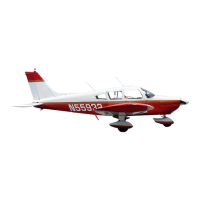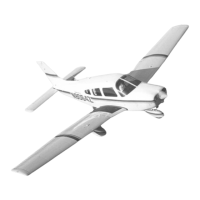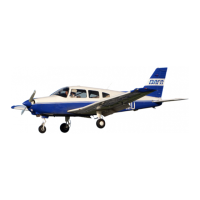PIPER AIRCRAFT CORPORATION
PA-2t.1ü, ARCHEn U
sEcTtoN
3
EMERGENCY PNOCEDURES
3.I9
LOSS
OF
FUEL PRESSURE
If loss
offuet
pr€ssure
occurs, turn
ON
the el€.tric fuel
pump
altd check
that lh€ fuel selector is on a full tank.
If the
problem
is not anempty tank,land as soon as
practical
and havc
the
€ngin€
driven
fuel
pump
and
fuel
system checked.
3.21 HIGH OIL TEMPERATURE
An abnormally high oillemperature indication may b€ caused
by a
low
oil level,an obstruction in the oil cooler, damaged orimprop€rbaffle seals,
a
defe€tive
gaug€,
or other causes. Irnd
as soonas
practical
at an appropriate
airport and have the cause inv€stigated.
A steady, rapid rise in
oil temperatur€ i! a sign of trouble. l-and ar th€
nearest airport and let a mechanic investigate
the
problem.
Watch
the oil
pressure gauge
for an accompanying loss of
pressure.
3.23 ELECTRICAL FAILURES
Loss oi alt€rnaior
outpur
is
detected through zero rerding on ihe
ammeter. Before executing the following
procedure,
insure that
thereadinS
is z€ro and not merelylow
byactuatingan elcctrically
powered
device, such
as the landing light. If
no incr€ase id the amm€ter
reading
is
noted,
alternator failure can
be assumed.
The
electrical load should be reduc€d
as much as
possible.
Ch€ck rhe
alernätor circuit
breakers for a
popped
circuir.
The next
step
is
to attempt to reset the overvoltage
relay. This is
accomplishcd by moving the
ALT switch to OFFfor one s€cond
and then to
ON. lf the trouble was caused
by
a
momentary overvolrage condition
(
16.5
volts
and up) this
procedureshould
return th€ammcrerto
anormalreading.
lf the
ammeter conrinues to indicate
'tr"
outDur. or ifthe altefnatorwill
nor remain reser. rurn offthe
ALTssirch, maindrn
mrnimum elecrricatload
and land as soon
as
practical.
All el€ctrical
load is being supplied
by the
battery.
ISSUED: JULY 2,
!979
REVISEDT JANUARY
14, l9El
REPORT: v&1120
3-lJ

